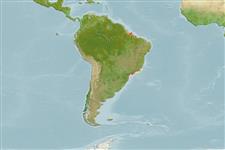Environment: milieu / climate zone / depth range / distribution range
Ecología
marino; salobre; rango de profundidad 1 - 22 m (Ref. 189). Tropical; 1°N - 27°S, 51°W - 32°W (Ref. 189)
Distribución
Países | Áreas FAO | Ecosistemas | Ocurrencias, apariciones | Point map | Introducciones | Faunafri
Southwest Atlantic: mouth of Para River southward to Cananéia, Brazil.
Tamaño / Peso / Age
Maturity: Lm ? range ? - ? cm
Max length : 6.8 cm SL macho / no sexado; (Ref. 189)
Short description
Morfología | Morfometría
Espinas dorsales (total): 0; Espinas anales 0; Radios blandos anales: 22 - 25. Snout short, about 1/2 eye diameter; maxilla shorter than in most other Anchoa species, tip pointed, not reaching beyond hind margin of pre-operculum; gill cover canals of walkeri-type. Pectoral fins large, reaching about pelvic fin origin; anal fin fairly long, its origin below or just before midpoint of dorsal fin base. A silver stripe along flank, less than eye diameter.
Presumably schooling along beaches and down to 22 m. A single specimen was recorded from Coqueiros at the mouth of the Paraguaçu River, thus able to tolerate lowered salinities. More data needed.
Life cycle and mating behavior
Madurez | Reproducción | Puesta | Huevos | Fecundidad | Larva
Spawn in school (Ref. 205).
Whitehead, P.J.P., G.J. Nelson and T. Wongratana, 1988. FAO Species Catalogue. Vol. 7. Clupeoid fishes of the world (Suborder Clupeoidei). An annotated and illustrated catalogue of the herrings, sardines, pilchards, sprats, shads, anchovies and wolf-herrings. FAO Fish. Synop. 125(7/2):305-579. Rome: FAO. (Ref. 189)
IUCN Red List Status (Ref. 130435)
Threat to humans
Harmless
Human uses
Pesquerías: sin interés
Más información
PaísesÁreas FAOEcosistemasOcurrencias, aparicionesIntroduccionesStocksEcologíaDietacomponentes alimenticiosconsumo de alimentoRación
Age/SizeCrecimientoLength-weightLength-lengthLength-frequenciesMorfometríaMorfologíaLarvaDinámica larvariaReclutamientoAbundanciaBRUVS
ReferenciasAcuiculturaPerfil de acuiculturaRazasGenéticaElectrophoresesheritabilidadEnfermedadesProcesamientoNutrientsMass conversion
ColaboradoresImágenesStamps, Coins Misc.SonidosCiguateraVelocidadTipo de nataciónSuperficie branquialOtolitosCerebrosVisión
Herramientas
Special reports
Download XML
Fuentes de Internet
Estimates based on models
Preferred temperature (Ref.
123201): 22.5 - 28.2, mean 27.3 °C (based on 81 cells).
Phylogenetic diversity index (Ref.
82804): PD
50 = 0.5000 [Uniqueness, from 0.5 = low to 2.0 = high].
Bayesian length-weight: a=0.00513 (0.00232 - 0.01135), b=3.14 (2.96 - 3.32), in cm total length, based on LWR estimates for this Genus-body shape (Ref.
93245).
Nivel trófico (Ref.
69278): 3.3 ±0.4 se; based on size and trophs of closest relatives
Resiliencia (Ref.
120179): Alto, población duplicada en un tiempo mínimo inferior a 15 meses (Preliminary K or Fecundity.).
Fishing Vulnerability (Ref.
59153): Low vulnerability (10 of 100).
Nutrients (Ref.
124155): Calcium = 544 [282, 1,400] mg/100g; Iron = 2.63 [1.41, 4.91] mg/100g; Protein = 17.1 [14.8, 19.8] %; Omega3 = 0.327 [0.152, 0.686] g/100g; Selenium = 33.6 [14.2, 83.5] μg/100g; VitaminA = 34.9 [10.4, 96.6] μg/100g; Zinc = 2.93 [1.91, 4.41] mg/100g (wet weight);
